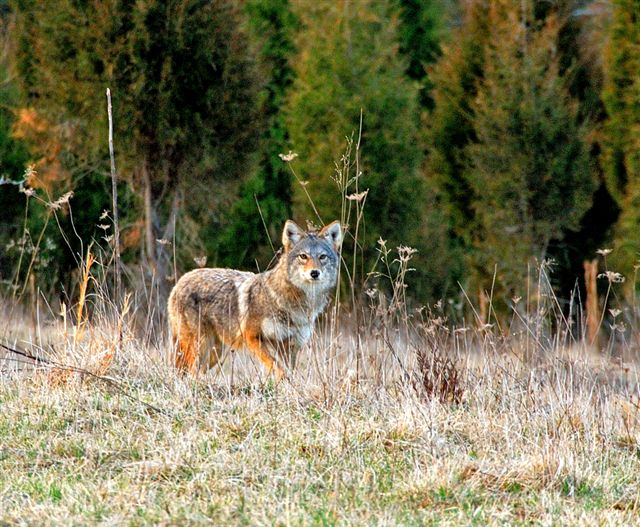
The coyote (Photo by Dave Slaughter)
By Gayle Pille
Special to NKyTribune
In an age when many species of animals are disappearing at an alarming rate, one species has increased its numbers a significantly since the first European explorers came to North America. Despite decades of persecution, the much maligned and poorly understood coyote is an American success story.
The coyote, Canis latrans, which means barking dog, is usually associated with open western territories. Prior to the 1950’s coyotes weren’t even seen east of the Mississippi. However, as humans eliminated the coyote’s more dominant relative, the gray wolf; and as we fragmented eastern forests, new areas opened up for the wily and adaptable coyote. The species has made a natural migration, moving east into New England along the U.S.-Canadian border and then moving south and west into the continental U.S. Today coyotes are found in all 49 continental states. Locally they’re found in every county in Ohio, Kentucky and Indiana.

Coyote in South Campbell County (Photo by Mike Hollan)
The “trickster” of American Indian legend owes its success to its ability to acclimatize. Coyotes can successfully live almost anywhere. Though seldom seen, they have set up shop in wooded areas throughout Northern Kentucky. They are true omnivores, eating whatever the environment offers. Common meals consist of groundhogs, flying squirrels, rabbits, whitetail fawns, mice, voles, skunks, birds, insects, berries, apples, corn, carrion, and even cats.
Coyotes help keep in check many species of animals folks complain about most, notably feral cats, deer, groundhogs, and mice. Nocturnal by nature, they will occasionally hunt during daylight hours when not threatened.
Coyotes occupy a territory of two to three square miles. They mate for life, start breeding at age two, and can live for up to 15 years. Breeding season between coyotes is between January and March. Six to eight pups are born in April or May in one of several den sites. Both parents hunt and feed the young.
At ten weeks parents start teaching the pups to hunt. By fall pups are seeking out their own territories, usually within ten miles of their parents. Naturally migratory, young coyotes have been known to relocate more than 100 miles from their birthplace. At least 75% of all pups born will not survive their first year.
Coyotes look like small scruffy German Shepherds, weighing in at 20 to 50 pounds. They are intelligent and have a very keen sense of smell, vision and hearing; can run at almost 40 mph and jump an 8-foot fence. They have been so intensely persecuted by humans that they instinctively know to fear and avoid us; an evasiveness that has served them well and enabled them to survive in rural areas, suburbs, and in large cities. Central Park in New York City has even been home to coyotes. Coyotes are very alert, wary and secretive. They have become very common, though you’d be hard pressed to find one.

Coyote in winter. (Photo by Dave Slaughter)
Often folks will hear a coyote rather than see one. Their howls can be deceiving, sounding like they’re one place when they’re really another. They have two howling seasons, with the first in January and February when pair bonds are being established. The second howling season is in September and October when the female calls to her offspring, with the young calling back in unison. It’s not uncommon for pet canines to hear coyotes howl and respond with howls of their own.
Coyotes are here to stay and fill a valuable niche in the food chain, keeping in check many small mammal populations. Killing coyotes usually serves no purpose. Since coyotes are highly territorial, killing off an alpha only opens up a territory for several more coyotes to move into, increasing populations in particular areas. They are very fearful of humans and usually offer only a glimpse of themselves before disappearing.
If you see or hear coyotes, consider yourself lucky and enjoy the show. Your experience will only be fleeting, but it’s a chance to imagine yourself in the Wild West with wagon trains, cowboys, Indians, and Old Man Coyote.
Gayle Pille is a local naturalist and nature writer who many know through her work to establish the five-mile network of nature trails at Highland Cemetery in Ft. Mitchell. She created the cemetery’s popular 25-year-old Wildlife Enhancement Program and works with a small team of volunteers to maintain the cemetery’s wooded walking paths. An avid birdwatcher, Gayle also builds custom wildlife nest boxes for businesses, parks and residences through her business, www.woodlandhabitat.com
Contact her at gaylepille@yahoo.com

























Gayle,
Your article on coyotes in Southern Campbell Co. was interesting, but did not, and I repeat, did not touch on how threatening coyotes are to city residents who have lost pets, especially dogs by hungry coyotes. A farmer in Southern Campbell recently told me if we don’t get the predictors under control, they WULL take over. Coyote have reduced the turkey population here in Campbell County. This defeats the hard work the state has put forth to get turkeys back here. And, the deer, especially the fawns are always vulnerable to coyote. All in all coyote destructiveness far outweighs their usefulness.